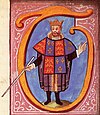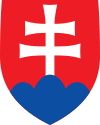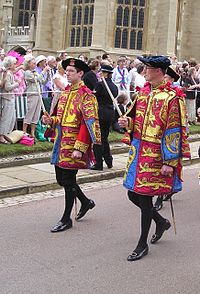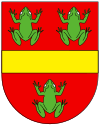Portal:Heraldry
Welcome to the Heraldry and Vexillology Portal!


Heraldry encompasses all of the duties of a herald, including the science and art of designing, displaying, describing and recording coats of arms and badges, as well as the formal ceremonies and laws that regulate the use and inheritance of arms. The origins of heraldry lie in the medieval need to distinguish participants in battles or jousts, whose faces were hidden by steel helmets.
Vexillology (from the Latin vexillum, a flag or banner) is the scholarly study of flags, including the creation and development of a body of knowledge about flags of all types, their forms and functions, and of scientific theories and principles based on that knowledge. Flags were originally used to assist military coordination on the battlefield, and have evolved into a general tool for signalling and identification, particularly identification of countries.
Selected coat of arms

The coat of arms of Slovakia is composed of a silver (argent) double cross, elevated on the middle peak of a dark blue mountain consisting of three peaks. It is situated on a red (gules) early gothic shield. Extremities of the cross are amplificated, and its ends are concaved. The same symbol (with other colours and minor changes) is in the sinister portion of the Hungarian coat of arms. (more...)
Selected article

"England expects that every man will do his duty" was a signal sent by Admiral Horatio Nelson, 1st Viscount Nelson from his flagship HMS Victory as the Battle of Trafalgar was about to commence on October 21, 1805. Trafalgar was the decisive naval engagement of the Napoleonic Wars. It gave the United Kingdom of Great Britain and Ireland control of the seas, removing all possibility of a French invasion and conquest of Britain. Although there was much confusion surrounding the wording of the signal in the aftermath of the battle, the significance of the victory and Nelson's death during the battle led to the phrase becoming embedded in the English psyche, and it has been regularly quoted, paraphrased and referenced up to the modern day. (more...)
Selected flag

The Red Ensign of Singapore is a civil ensign used by privately-owned, non-military ships that are registered in Singapore. The overall design of the ensign is a modification of the national flag, with the ratio of the width to the length extended to 1:2. The ensign was created by law in 1966. The use of this ensign is regulated by the Maritime and Port Authority of Singapore (MPA). According to the MPA, the Red Ensign is the only ensign to be used on Singaporean civilian ships, and the national flag is not an acceptable substitute. The ensign must be hoisted on all Singaporean ships on entering or leaving port. (more...)
Selected picture

Pursuivants in procession to St George's Chapel, Windsor Castle for the 2006 service of the Order of the Garter: Peter O'Donoghue, Bluemantle Pursuivant of Arms in Ordinary (left), Alastair Bruce of Crionaich, Fitzalan Pursuivant of Arms Extraordinary (right).
Did you know...
- ...that medieval heraldry attributed a coat of arms (pictured) to Satan based on a Bible verse mentioning "three unclean spirits like frogs"?
- ...that British paediatrician June Lloyd, Baroness Lloyd of Highbury is commemorated by the Royal College of Paediatrics and Child Health as one of the supporters in their coat of arms?
- ...that the Seal of Oregon includes a British man-of-war departing and an American steamer arriving?
- ...that the flags hoisted by the Finnish icebreaker Tarmo on 3 March 1918 included a large white tablecloth?
- ...that the Treaty of Grimnitz allowed Brandenburgian prince-electors to touch Pomeranian flags?
Related portals
|
|
|
Heraldry Web resources
Authorities
- Belgium - The Council of Nobility, Flemish Heraldic Council and Council of Heraldry and Vexillology of the French Community
- Canada - Canadian Heraldic Authority and see also Public Register of Arms, Flags and Badges
- England, Wales, and Northern Ireland - The College of Arms
- Ireland - The Office of the Chief Herald of Ireland
- Netherlands - High Council of Nobility
- Portugal - Instituto da Nobreza Portuguesa
- Scotland - The Court of the Lord Lyon
- South Africa - South African Bureau of Heraldry
- Sweden - National Board of Heraldry, The National Archive
- United States Army - The United States Army Institute of Heraldry
Societies
- Greek Heraldry Society
- The Academy of Heraldic Science Czech republic
- The American College of Heraldry
- The American Heraldry Society
- The Augustan Society
- The Australian Heraldry Society Inc.
- Bulgarian Heraldry and Vexillology Society
- The Center for Research of Orthodox Monarchism
- Cambridge University Heraldic and Genealogical Society
- Chiltern Heraldry Group
- The College of Dracology
- Croatian Heraldic and Vexillologic Association
- The Finnish Heraldic Society
- Fryske Rie foar Heraldyk
- Hellenic Armigers Society
- Guild of Heraldic Artists
- Genealogical Society of Ireland
- Heraldry Research Institute (Japan)
- The Heraldry Society
- The Heraldry Society of Africa
- The Heraldry Society of New Zealand Inc.
- The Heraldry Society of Scotland
- The Heraldry Society of Southern Africa
- The Institute of Heraldic and Genealogical Studies
- The International Association of Amateur Heralds
- Italian Center of Vexillological Studies
- Lancashire Heraldry Group
- Macedonian Heraldry Society
- New England Historic Genealogical Society Committee on Heraldry
- Norwegian Heraldry Society
- Oxford University Heraldry Society
- Polish Heraldry Society
- Polish Nobility Confederation
- Real Academia Matritense de Heráldica y Genealogía - Royal Academy of Heraldry and Genealogy of Madrid
- Romanian Institute for Genealogy and Heraldry
- The Royal Heraldry Society of Canada
- The Russian College of HeraldryThe Russian College of Heraldry
- Serbian Heraldic Society
- Societas Heraldica Scandinavica
- Societas Heraldica Slovenica
- Swedish Heraldic Society
- Ukrainian Heraldry Society
- Royal Association Genealogical and Heraldic Office of Belgium
Vexillology
Software
- Coat of Arms Visual Designer web-based program
- Puncher Heraldry Program
- Blazonry Server - pyBlazon
- DrawShield - creates SVG shield or arms image from blazon
- CoaMaker - web-based tool
- Blazon95 and BLAZONS! 2000, older Windows applications
Texts
- Heraldry, historical and popular : with seven hundred illustrations (1863)
- A Complete Guide to Heraldry (1909)
Other
Wikimedia
The following Wikimedia Foundation sister projects provide more on this subject:
-
Commons
Free media repository -
Wikibooks
Free textbooks and manuals -
Wikidata
Free knowledge base -
Wikinews
Free-content news -
Wikiquote
Collection of quotations -
Wikisource
Free-content library -
Wikispecies
Directory of species -
Wikiversity
Free learning tools -
Wikivoyage
Free travel guide -
Wiktionary
Dictionary and thesaurus












